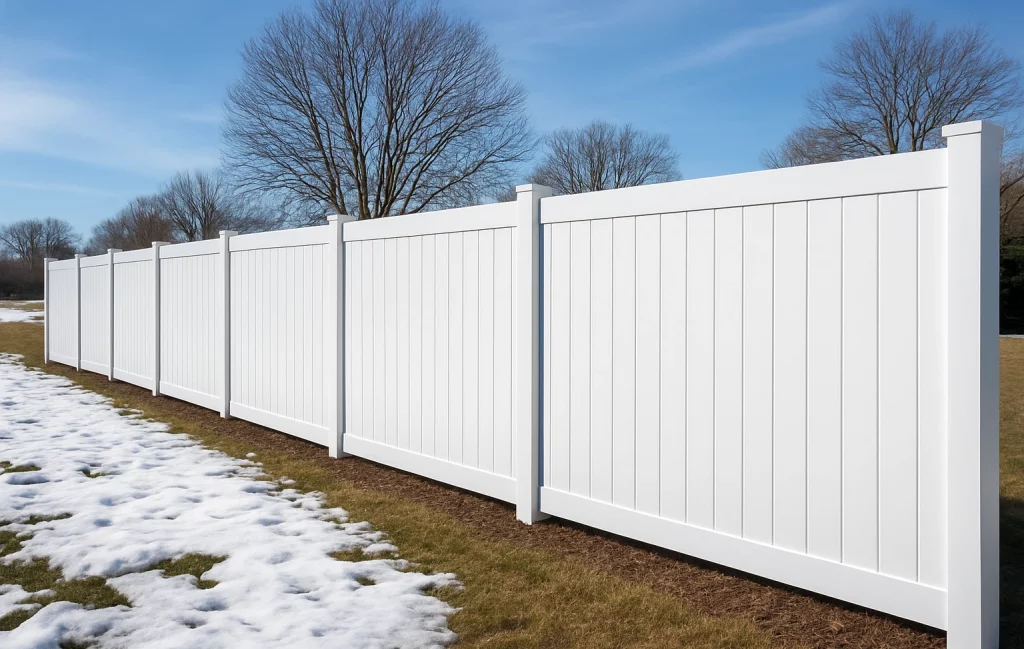Adapting Vinyl Fencing to Different Climates is essential for ensuring that your investment remains strong and beautiful year after year. Across the U.S.—and especially in Chicago—property owners face a wide range of temperatures, from freezing winters to humid summers. Vinyl fences have become one of the most reliable solutions thanks to their flexibility, durability, and low maintenance needs.
A well-installed Vinyl Fence Chicago can adapt easily to these environmental shifts while preserving its structure and color. Understanding how climate affects vinyl helps homeowners and contractors select the right materials and installation techniques for long-term success.
Why Vinyl Fencing Is Weather-Resistant
Vinyl is a synthetic material engineered to endure changing weather conditions. Its composition—primarily polyvinyl chloride (PVC)—allows it to expand and contract slightly without cracking or losing shape.
In extreme heat, vinyl softens slightly to release tension, while in cold temperatures, additives like impact modifiers prevent brittleness. This dynamic flexibility gives vinyl fences an edge over materials like wood or metal that warp or rust when exposed to moisture and temperature swings.
Performance in Hot Climates
In warmer regions, prolonged exposure to sunlight can cause many materials to fade or weaken. Vinyl, however, is equipped with UV inhibitors that shield its surface from the sun’s rays, preventing discoloration and maintaining a fresh appearance.
Modern formulations also include titanium dioxide to reflect UV radiation and reduce heat absorption, keeping the panels cooler to the touch. Regular cleaning and minimal maintenance are enough to maintain a vinyl fence’s smooth finish, even under direct summer sunlight.
Performance in Cold and Snowy Environments
Cold climates can cause materials to contract, leading to cracks or breaks—but vinyl’s elasticity allows it to flex slightly instead. In areas like Chicago, where freeze-thaw cycles are common, professional installation with proper post-depth and drainage is key to preventing frost heaving.
Partnering with experienced Commercial Fence Contractor in Chicago ensures your vinyl fence is reinforced for shifting ground conditions, strong wind loads, and heavy snowfall. Proper footing depth and high-quality hardware will protect your fence year-round.
Handling Humidity and Moisture
Humidity and moisture are constant enemies of wooden or metal fencing—but not of vinyl. Its non-porous surface prevents water absorption, eliminating problems like rot, rust, or mold buildup.
For maximum longevity, ensure posts are installed with adequate airflow and that any debris or standing water is cleared periodically. This simple maintenance routine keeps the fence sturdy and visually appealing for decades.
Complementary Fence Materials for Different Climates
While vinyl performs exceptionally well across climates, combining it with other fencing materials can enhance both aesthetics and strength.
For properties emphasizing modern or decorative finishes, Aluminum Fences Chicago provide a lightweight, corrosion-resistant complement.
Meanwhile, Wood Fence in Chicago remains a timeless choice for areas with moderate weather, offering warmth and traditional appeal alongside vinyl’s sleek structure.
These material pairings allow flexibility in design and function—perfect for projects that must adapt to Chicago’s seasonal extremes.
Sustainability and Long-Term Performance
Vinyl fences are not only durable but also eco-conscious. Many manufacturers now produce PVC using recycled materials, reducing waste while maintaining quality. Additionally, vinyl requires no chemical sealants, stains, or paints, minimizing harmful runoff and environmental impact.
For more information on sustainable fencing materials and climate performance, visit the National Renewable Energy Laboratory (NREL), a leading authority on energy-efficient building materials and weather adaptation standards.
Maintenance Practices for All Climates
One of vinyl’s biggest advantages is its minimal upkeep. Still, a few small steps can ensure its long-term durability:
Clean surfaces twice a year with mild soap and water.
Inspect posts and caps annually for secure alignment.
Trim vegetation around the fence line to reduce moisture buildup.
Avoid harsh chemicals that could damage the finish.
These practices keep vinyl fences looking brand new and structurally sound through every season.
Conclusion
Vinyl fencing remains one of the most adaptable materials for properties facing varied climates. Its resistance to temperature extremes, humidity, and UV exposure makes it ideal for both residential and commercial use.
With proper installation, high-quality materials, and minimal maintenance, a vinyl fence offers a lasting combination of strength, flexibility, and aesthetic value. Whether under summer heat or winter snow, vinyl continues to prove itself as a reliable, weather-resistant fencing solution.

